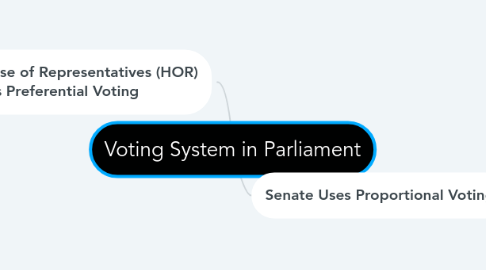
1. House of Representatives (HOR) uses Preferential Voting
1.1. Why is it used?
1.1.1. Voters rank candidates in the order of their choice
1.1.2. Provides for multiple counts of ballot papers to occur
1.1.2.1. Determining who acquired absolute majority = 50%+1 formal votes
1.1.3. Delivers a result satisfactory to more voters
1.1.4. Re-distributed until absolute majority reached = 50% above
1.1.4.1. Reduces vote wastage
1.1.4.2. Voter's first candidate not elected, vote may be re-examined, and other preferences taken into account
1.2. Strengths
1.2.1. How to vote cards used by major parties to influence others votes
1.2.2. Ensures only candidate with support of absolute majority of the electorate can win
1.2.2.1. Eliminating the possibility of minority winners
1.2.2.2. Winning candidate is the most preferred or least disliked candidate
1.2.3. Ensures that voters can support minor parties and independent candidates
1.2.3.1. Votes for minor parties and independents are not wasted
1.2.3.2. Allows minor parties to influence votes with second preferences
1.2.4. Allows people to have their other choices and views represented
1.2.5. Allows parties with similar policies to exchange preferences to assist each other to win
1.2.6. Promotes a strong two-party system
1.2.6.1. Ensuring stability in the parliamentary process
1.2.6.2. Most Representative of Votes party choice
1.2.7. Reduces Vote Wastage
1.3. Weaknesses
1.3.1. More complicated to administer and count
1.3.2. Increases the chances of informal voting occurring
1.3.3. Two-party system damages the minor parties and independents
1.3.3.1. Not representative of all of Australia as a whole society
1.3.3.2. Only small majority make it into HOR
1.3.4. Voters are forced to express a preference for candidates
1.3.4.1. Even though they may not wish to support in any way
1.3.5. Requires educated voters
1.3.5.1. Not everyone is fully informed about policies
1.3.5.2. People may vote for parties without nothing they beliefs/policies
1.3.6. Follow ‘How to Vote Card’ without knowing what their voting for
1.3.6.1. People may vote for parties without nothing they beliefs/policies
1.3.6.2. Make uninformed decision
2. Senate Uses Proportional Voting
2.1. Why is It used?
2.1.1. One vote, all votes have same value
2.1.2. Can decide whether to fill in all the boxes or only some of them
2.1.3. Votes transferrable
2.1.4. Candidates & parties elected in proportion to level of support among voters
2.1.5. Used to increase the chance of minor parties and independents winning seats
2.2. Strengths
2.2.1. Mirrors Australia's demographic more accurately
2.2.1.1. Due to the lower quota to be fulfilled
2.2.1.2. More independent parties may be elected
2.2.1.3. Much more reflective of individuals
2.2.2. Balance of power
2.2.2.1. Independent make final choice on whether law should be passed
2.2.2.1.1. Allows for proper scrutiny of laws, benefits the people
2.2.2.1.2. As no majority party has majority in senate
2.2.3. Allows for multi-party system to occur
2.2.4. More representative of wishes of electorate
2.2.4.1. Parties win seats in proportion to percentage of votes recieved
2.2.5. Votes go further = citizens more invovled
2.2.6. Quota is much easier to meet
2.2.6.1. 14% < 50% +1
2.3. Weaknesses
2.3.1. Complicated, costly and time-consuming to administer and count
2.3.1.1. Whole process of sorting votes = long time to process
2.3.1.2. Difficult for those involved
2.3.1.2.1. Any complications could throw off the election process
2.3.2. No absolute majority
2.3.2.1. Percentage of voters needed to be elected is roughly around 14% = quota
2.3.2.2. Means system could end up unstable
2.3.3. Promotes instability in Parliament
2.3.3.1. Balance of power held by a number of members
2.3.3.1.1. Elected by a small minority of the electorate
2.3.3.2. Crossbench hold more power over government/opposition
